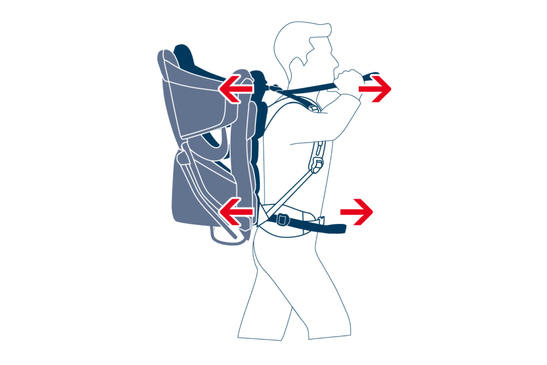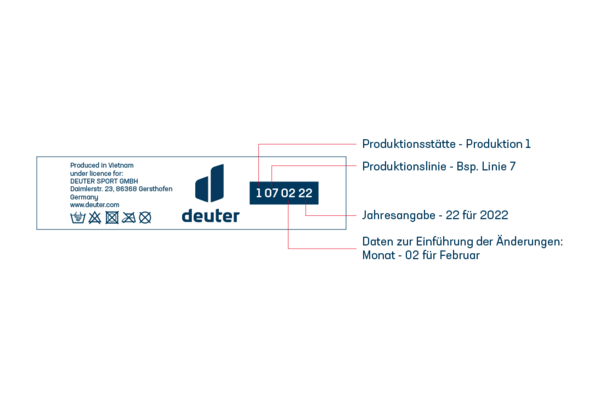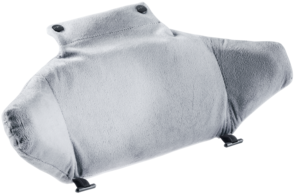Child carrier advice from deuter

Child carrier advice from deuter
Take your little ones on all your adventures into the great outdoors and share in the enjoyment of discovering exciting new paths.
FAQs
- Child carriers are suitable for up to what carrying weight?
- How do I properly adjust a child carrier?
- How do I determine the right seating position for my child?
- What is the correct way to put on the child carrier?
- How do I properly clean the child carrier?
- How do I properly attach or configure the sun roof?
- How do I properly attach or configure the rain cover?
- Where is the hydration bladder placed?
- What do I need to do each time before using the child carrier?
- How do I check my child carrier for functionality?
- Can deuter test my child carrier for product safety?
- Is my child carrier repairable?
- How can I read the year of production or how can I find out the age of my child carrier?
- Where is the user manual?
- What are the differences between the Kid Comfort models?
- What accessories are available for the child carrier?

Child carriers are suitable for up to what carrying weight?

Child carriers are suitable for up to what carrying weight?
You can start using a child carrier as soon as your child can sit up independently!
Your child should be able to assume a sitting position on their own and have good head control. This usually starts at eight months, but your child may learn this skill before or only after this milestone date.
The maximum load of the child carrier is 22 kg (18 kg for the child + 4 kg for the cargo). The product has been tested by TÜV up to this weight and complies with the European standard EN 13209-1:2022.
Since children develop at different rates, we cannot provide a figure for maximum body weight.
Properly adjusting the child carrier
Step 1:

1.1
First, loosen all the straps. Load and shoulder the child carrier with a realistic load, though not yet with your child.

1.2
Center the hip belt over your pelvic bones and tighten.

1.3
Tighten the shoulder straps while making sure to carry the main weight using the hip belt.

1.4
Ideally, the strap attachment should be positioned between the shoulder blades. To do this, position the shoulder straps higher or lower by adjusting the back length.

1.5.
The VariSlide continuous back length adjustment on the Kid Comfort and Kid Comfort
Pro models:
Thanks to this system, you can continuously adjust the back length with precision in a flash. To do this, lift the central plastic buckle that is attached to the back system. At the same time, pull or push the shoulder straps into the suitable position.

1.5.1
The VariQuick multistep back length adjustment on the Kid Comfort Active SL and Kid Comfort Active models:
Open the Velcro strap in the center of the carrier and guide it through the 4 matching attachment loops.

1.5.2
Then tighten the Velcro and secure it again.

1.6
Now adjust the angle of the position adjustment straps:
Thread the lower buckle for back lengths S-M or the upper one for back lengths M-L. Tighten the position adjustment on the shoulder straps and hip belt so that the child carrier is snugly positioned against your back. This provides more stability in difficult terrain. You can loosen these straps slightly to provide more ventilation. As soon as the carrier system has been adjusted to your back length, remove the child carrier and continue adjusting the seat height.
Step 2:

2.1
Set the carrier down on the floor. Loosen the side straps and open the side access. Also loosen and open the 5-point safety belt.

2.2
Now lower the child seat into the lowest position. To do this, fold the chin pad up, lift the seat height adjustment buckle, and push the seat down with your hand.

2.3
Stand at the back of the carrier and check that it is stable. Always place one foot on the folding leg to secure the carrier during further adjustment steps.

2.4
You can now lift the child into the carrier or let them climb in from the side while supporting it. Put the child's arms through the safety belt shoulder straps and fasten the child's chest belt.

2.5
The seat height is optimally adjusted when the child's chin is just above the chin pad. The child should be able to see out of the carrier and move their arms as freely as possible. To raise the seat to the ideal height, pull the adjustment strap until the child's chest is level with the seat height adjustment buckle. Support the movement of the seat from below using your other hand.
Step 3:

3.1
Now that the child seat is adjusted to the ideal height, insert the two buckles of the 5-point safety belt into the color-coded buckles on the side of the seat.

3.2
The shoulder strap attachment of the safety belt should be located between the child's shoulder blades: Reach behind the child's back, loosen the Velcro strap of the shoulder strap, and press it back into the appropriate position.

3.3
Then pull the shoulder straps of the 5-point safety belt tight, but not too tight.
Fold the chin pad down.

3.4
Close the side access and tighten the straps on the two side straps.

The width of the seat cushion varies in relation to the set height and, in conjunction with the footrests, allows for an age-appropriate sitting position.
Depending on the seating position, the footrests must be installed in the upper A) or lower B) position/buckle. When changing the position, the footrests should be kept out of the child's reach. The following generally applies: For smaller children with a higher seat setting, attach the footrests to the upper position. For larger children with a lower seating position, attach the footrests in the lower position. Accordingly, you can set the ideal height of the continuously adjustable footrests by pulling or loosening the straps.
How can I determine the right seating position for my child?
You can easily adjust the height of the seat, even when the child is already in a sitting position. To lower the seat, lift the buckle under the chin pad. To raise the seat, tighten the adjustment strap. Use your other hand to support the movement of the seat from below.
You have set the ideal sitting position

You have set the ideal sitting position
once the child's chin is level with the seat height adjustment buckle.
A. The higher the position of the seat, the wider it will be, allowing for a natural spread-squat position for toddlers. The child’s legs should be slightly bent in the footrests.
B: The more the seat is lowered, the narrower it will be for an upright sitting position for slightly older children. Place the footrests here so that your child’s legs are neither dangling freely nor excessively bent. Finally, tighten the lower straps of the foot straps enough to prevent your child’s feet slipping off.
Putting on the child carrier correctly

1.
Check the safety belt and side access again to make sure it is properly fastened. Now go to the back of the child carrier. Use one hand to hold the handle on the headrest to secure the carrier.
Please perform this step carefully!
Grab the handle on the back with your free hand. You can now release your grip on the headrest handle. Check whether the shoulder straps on the carrying system are loose and the chest and hip straps are open. Make sure that when putting on the child carrier there are no obstacles that you could bump it in to.
Perform the following steps carefully without making any sudden movements.

2.
Position your feet about shoulder-width apart. Lift the carrier by the handle on the back with one hand and support yourself on your slightly bent leg on the opposite side.

3.
Slip your free arm into the matching shoulder strap and use it to carry the full weight of the carrier. Then let go of the handle and slip your other hand into the other shoulder strap.

4.
Center the hip belt over your pelvic bones and tighten.

5.
Then adjust the shoulder straps. Finally, slide the chest strap to the desired height and lock it.

6.
Finally, push in the stand bracket. You should hear an audible "click" when the stand is locked in the standing or transport position. To put the child carrier down, follow the same steps for putting it on in the reverse order.
HOW DO I PROPERLY CLEAN THE CHILD CARRIER?
Place the kid carrier in a basin or bath tub and wash them using a pH-neutral soap (e.g., curd soap or a few drops of dishwashing liquid). Please do not use any aggressive cleaning agents! The best way to clean away dirt from the upholstery and belt straps is to use a mixture of vinegar essence and water. You can then easily remove dirt from the fabric coverings with a brush. You can clean sweat stains from the carrying system by manually rubbing the pieces together with soap and plenty of water. Then set out to air dry.
Hand wash only: do not place in the dryer or washing machine!
Please do not put any part of the carrier system in the washing machine, because the material will wear out from abrasion stress and can become damaged over time. Residues may often be left behind by detergents, which for example can irritate wearers with sensitive skin. The chemical reaction caused by the combination of sweat, detergent residues, and UV radiation will also decompose the materials faster.
...AND HOW DO I CLEAN THE CHIN PAD CORRECTLY?
The removable chin pad is washable and can be cleaned by hand with lukewarm water and a neutral soap. Please air dry and do not place in the dryer.
How do I properly attach or configure the sun roof?
First you must attach the sun roof or fold it out (for the Pro model) and secure it accordingly.
PLEASE NOTE:
Check your child's skin regularly, because small children have very sensitive skin. Protect your child from UV rays by using the sun roof, which is available as an accessory for the Kid Comfort Active, included with the Kid Comfort, and permanently integrated into the Kid Comfort Pro.
You should only obtain additional or spare parts from the manufacturer or our retail partners.
The following is a step-by-step guide to the product:
What kind of UV protection does the sun roof offer?
Even if the fabric covering blocks all or most UV radiation, your child will still be exposed to UV radiation:
- Children can still be sunburned from diffused light. Therefore, we also recommend that you apply sunscreen to your child and have them wear a hat and sunglasses.
- It is also important to protect their legs, feet, and arms, since these are exposed to the sun and cannot be protected by the sun roof.
How do I properly attach or configure the rain cover?
After attaching the sun roof, pull the rain cover over the child carrier from bottom to top.
Then you can secure it using the two securing straps for the sun roof.
To do this, thread the fastening strap through the side eyelets, which are located on the inside of the Rain Cover. Then click the straps back into the matching straps on the child carrier, located above the viewing window.
PLEASE NOTE: For safety reasons, we recommend attaching the rain cover without a child in the carrier!
Where do I place the hydration bladder?
Place the hydration bladder in the zippered compartment between the child and the back part of the child carrier. You can then thread the drinking tube through the elastic loop on the left shoulder strap (heart side). That way you can keep everything well stowed away.
safety note

safety note
The deuter Kid Comfort was the first child carrier in the world to earn the TÜV/GS seal
All materials are checked in advance and approved accordingly for production. We satisfy all TÜV criteria here and also use materials that comply with the Bluesign standard.
What do I need to do each time before using the child carrier?
Before use, it should be checked whether all straps and buckles are functional. Never use the baby carrier if it has been damaged (bent frame, broken buckles, open seams, etc.).
Never try to bend a bent frame back into its correct shape yourself.
How do I check my child carrier for functionality?
We recommend the following steps to check for yourself:
- Systematically check all buckles and harness clamps for proper function. To do this, close all buckles - tighten them - and open them up again. Check the components for cracks or small fractures/chips. When closed, the buckles should hold together securely and tightly.
- Pull all webbing straps and check that they are tight on the sutures. Check the webbing along its length to see if there is any damage (rubbing, mousing or fraying).
- Unfold the base of the frame and place the carrier on a flat surface. Press on the stretcher from above - the stretcher should rest firmly on the ground without giving much. If it strongly tilts or gives way, then you should take a closer look at the frame.
- Open seams and strength of the carrying system - Check whether the shoulder straps and hip belts and respective plastic components are firmly connected and have no cracks or breaks.
- Our basic recommendation: Do not use child carriers older than 10 years (production year before 2011), as they no longer comply with current safety standards and norms. Furthermore, due to the aging and decomposition of natural material, further safety defects can occur which are not visible from the outside. Non-destructive testing is no longer possible here (e.g. testing of specified tensile strengths).
Can deuter test my child carrier for product safety?
Unfortunately, deuter cannot test your child carrier for safety and functionality. We recommend for you to check on your own before each use.
Your child carrier will no longer be functional after it has been tested in accordance with the standards.
Is my child carrier repairable?
We can carry out the following repairs (subject to a check in advance either with a picture or directly in our repair department), theoretically for all child carriers that are not older than 10 years, as long as it makes technical and financial sense to do so:
- Replace buckle(s) and other plastic parts or hip belt.
- Sew over holes in the material with patches
- Replace carrying straps (shoulder straps)
- Replace frame
How can I read the year of production or how can I find out the age of my child carrier?
The production code is printed on a small white or black "flag". This can be found in the Kid Comfort's pack sack (the storage space underneath the child). The last two digits indicate the year of production, so it can be determined when the carrier was produced.
It looks like this:

Please note that child carriers produced more than 10 years ago can no longer be repaired!
If you have any further questions, please contact our customer service.
WHERE IS THE USER MANUAL FOR MY MODEL?
You can download the user manual here.









